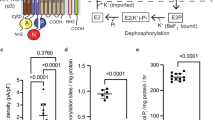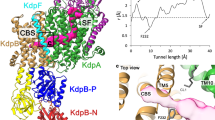Abstract
P-type ATPases pump ions across membranes, generating steep electrochemical gradients that are essential for the function of all cells. Access to the ion-binding sites within the pumps alternates between the two sides of the membrane1 to avoid the dissipation of the gradients that would occur during simultaneous access. In Na+,K+-ATPase pumps treated with the marine agent palytoxin, this strict alternation is disrupted and binding sites are sometimes simultaneously accessible from both sides of the membrane, transforming the pumps into ion channels (see, for example, refs 2, 3). Current recordings in these channels can monitor accessibility of introduced cysteine residues to water-soluble sulphydryl-specific reagents4. We found previously5 that Na+,K+ pump-channels open to the extracellular surface through a deep and wide vestibule that emanates from a narrower pathway between transmembrane helices 4 and 6 (TM4 and TM6). Here we report that cysteine scans from TM1 to TM6 reveal a single unbroken cation pathway that traverses palytoxin-bound Na+,K+ pump-channels from one side of the membrane to the other. This pathway comprises residues from TM1, TM2, TM4 and TM6, passes through ion-binding site II, and is probably conserved in structurally and evolutionarily related P-type pumps, such as sarcoplasmic- and endoplasmic-reticulum Ca2+-ATPases and H+,K+-ATPases.
This is a preview of subscription content, access via your institution
Access options
Subscribe to this journal
Receive 51 print issues and online access
$199.00 per year
only $3.90 per issue
Buy this article
- Purchase on Springer Link
- Instant access to full article PDF
Prices may be subject to local taxes which are calculated during checkout




Similar content being viewed by others
References
Läuger, P. Electrogenic Ion Pumps (Sinauer, 1991)
Scheiner-Bobis, G., Meyer zu Heringdorf, D., Christ, M. & Habermann, E. Palytoxin induces K+ efflux from yeast cells expressing the mammalian sodium pump. Mol. Pharmacol. 45, 1132–1136 (1994)
Artigas, P. & Gadsby, D. C. Na+/K+-pump ligands modulate gating of palytoxin-induced ion channels. Proc. Natl Acad. Sci. USA 100, 501–505 (2003)
Karlin, A. & Akabas, M. H. Substituted-cysteine accessibility method. Methods Enzymol. 293, 123–145 (1998)
Reyes, N. & Gadsby, D. C. Ion permeation through the Na+,K+-ATPase. Nature 443, 470–474 (2006)
Toyoshima, C., Nomura, H. & Tsuda, T. Lumenal gating mechanism revealed in calcium pump crystal structures with phosphate analogues. Nature 432, 361–368 (2004)
Toyoshima, C., Nakasako, M., Nomura, H. & Ogawa, H. Crystal structure of the calcium pump of sarcoplasmic reticulum at 2.6 Å resolution. Nature 405, 647–655 (2000)
Toyoshima, C. & Nomura, H. Structural changes in the calcium pump accompanying the dissociation of calcium. Nature 418, 605–611 (2002)
Olesen, C. et al. Dephosphorylation of the calcium pump coupled to counterion occlusion. Science 306, 2251–2255 (2004)
Sørensen, T. L. M., Møller, J. V. & Nissen, P. Phosphoryl transfer and calcium ion occlusion in the calcium pump. Science 304, 1672–1675 (2004)
Toyoshima, C. & Mizutani, T. Crystal structure of the calcium pump with a bound ATP analogue. Nature 430, 529–535 (2004)
Olesen, C. et al. The structural basis of calcium transport by the calcium pump. Nature 450, 1036–1042 (2007)
Toyoshima, C. et al. How processing of aspartylphosphate is coupled to luminal gating of the ion pathway in the calcium pump. Proc. Natl Acad. Sci. USA 104, 19831–19836 (2007)
Sakmann, B. & Neher, E. Single-Channel Recording (Plenum, 1995)
Guennoun, S. & Horisberger, J. D. Structure of the 5th transmembrane segment of the Na,K-ATPase α subunit: a cysteine-scanning mutagenesis study. FEBS Lett. 482, 144–148 (2000)
Guennoun, S. & Horisberger, J. D. Cysteine-scanning mutagenesis study of the sixth transmembrane segment of the Na,K-ATPase α subunit. FEBS Lett. 513, 277–281 (2002)
Horisberger, J. D., Kharoubi-Hess, S., Guennoun, S. & Michielin, O. The fourth transmembrane segment of the Na,K-ATPase α subunit: a systematic mutagenesis study. J. Biol. Chem. 279, 29542–29550 (2004)
Artigas, P. & Gadsby, D. C. Ouabain affinity determining residues lie close to the Na/K pump ion pathway. Proc. Natl Acad. Sci. USA 103, 12613–12618 (2006)
Nielsen, J. M., Pedersen, P. A., Karlish, S. J. & Jorgensen, P. L. Importance of intramembrane carboxylic acids for occlusion of K+ ions at equilibrium in renal Na,K-ATPase. Biochemistry 37, 1961–1968 (1998)
Ogawa, H. & Toyoshima, C. Homology modeling of the cation binding sites of Na+K+-ATPase. Proc. Natl Acad. Sci. USA 99, 15977–15982 (2002)
Morth, J. P. et al. Crystal structure of the sodium-potassium pump. Nature 450, 1043–1049 (2007)
Artigas, P. & Gadsby, D. C. Large diameter of palytoxin-induced Na/K pump channels and modulation of palytoxin interaction by Na/K pump ligands. J. Gen. Physiol. 123, 357–376 (2004)
Harmel, N. & Apell, H. J. Palytoxin-induced effects on partial reactions of the Na,K-ATPase. J. Gen. Physiol. 128, 103–118 (2006)
Canessa, C. M., Horisberger, J. D., Louvard, D. & Rossier, B. C. Mutation of a cysteine in the first transmembrane segment of Na,K-ATPase α subunit confers ouabain resistance. EMBO J. 11, 1681–1687 (1992)
Einholm, A. P., Toustrup-Jensen, M., Andersen, J. P. & Vilsen, B. Mutation of Gly-94 in transmembrane segment M1 of Na+,K+-ATPase interferes with Na+ and K+ binding in E 2 P conformation. Proc. Natl Acad. Sci. USA 102, 11254–11259 (2005)
Einholm, A. P., Andersen, J. P. & Vilsen, B. Importance of Leu99 in transmembrane segment M1 of the Na+,K+-ATPase in the binding and occlusion of K+ . J. Biol. Chem. 282, 23854–23866 (2007)
Rakowski, R. F. et al. Sodium flux ratio in Na/K pump-channels opened by palytoxin. J. Gen. Physiol. 130, 41–54 (2007)
Hodgkin, A. L. & Keynes, R. D. The potassium permeability of a giant nerve fibre. J. Physiol. (Lond.) 128, 61–88 (1955)
Zhang, Z., Lewis, D., Strock, C. & Inesi, G. Detailed characterization of the cooperative mechanism of Ca2+ binding and catalytic activation in the Ca2+ transport (SERCA) ATPase. Biochemistry 39, 8758–8767 (2000)
Inesi, G. Sequential mechanism of calcium binding and translocation in sarcoplasmic reticulum adenosine triphosphatase. J. Biol. Chem. 262, 16338–16342 (1987)
Acknowledgements
We thank N. Fataliev for help with molecular biology, the late R. F. Rakowski for cDNAs encoding Xenopus α1 and β3 Na+,K+-ATPase subunits, and P. Nissen, B. Vilsen and J. V. Møller for providing atomic coordinates before their publication. The work was supported by a grant from the NIH (to D.C.G.) and a fellowship from the Vicente Trust (to P.A.); N.R. is presently a Jane Coffin Fund Fellow. We dedicate this paper to the memory of our colleague R. F. Rakowski.
Author information
Authors and Affiliations
Corresponding author
Supplementary information
Supplementary Information
This file contains Supplementary Figures 1-8 with Legends. (PDF 3687 kb)
Supplementary Movie
This movie file shows a 360° view of ion pathway through palytoxin bound Na+,K+-ATPase. Rotating Na+,K+-ATPase TM domain homology model (based on the E2·BeF3-structure of SERCA) in which atoms of MTSET+-reactive positions are shown as red spheres, and the rest as cartoons, as in Supplementary Fig. 2c. TM helices 3 and 7-10 are coloured grey; the others are TM1 (pale blue), TM2 (magenta), TM4 (blue), TM5 (purple) or TM6 (green). (MOV 26320 kb)
Rights and permissions
About this article
Cite this article
Takeuchi, A., Reyes, N., Artigas, P. et al. The ion pathway through the opened Na+,K+-ATPase pump. Nature 456, 413–416 (2008). https://doi.org/10.1038/nature07350
Received:
Accepted:
Published:
Issue Date:
DOI: https://doi.org/10.1038/nature07350
This article is cited by
-
Structural–functional aberrations of erythrocytes in the northern red-backed vole (Clethrionomys rutilus Pallas, 1779) that inhabits the zone of influence of the copper smelter (the Middle Ural)
BioMetals (2023)
-
Effect of a purine derivative containing selenium to improve memory decline and anxiety through modulation of the cholinergic system and Na+/K+-ATPase in an Alzheimer’s disease model
Metabolic Brain Disease (2021)
-
Glutamate Transporters/Na+, K+-ATPase Involving in the Neuroprotective Effect as a Potential Regulatory Target of Glutamate Uptake
Molecular Neurobiology (2016)
-
Model of Cation Transportation Mediated by High-Affinity Potassium Transporters (HKTs) in Higher Plants
Biological Procedures Online (2015)
-
Simulation of alcohol action upon a detailed Purkinje neuron model and a simpler surrogate model that runs >400 times faster
BMC Neuroscience (2015)
Comments
By submitting a comment you agree to abide by our Terms and Community Guidelines. If you find something abusive or that does not comply with our terms or guidelines please flag it as inappropriate.



